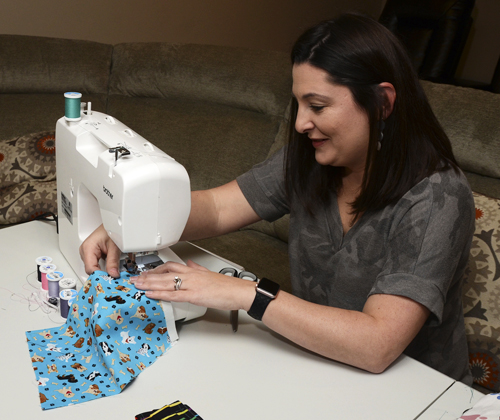Mahoning Valley sews together masks
Residents do their part to supply medical workers with needed gear

Staff photo / R. Michael Semple Joy Hromyak of Howland sews a mask that will be donated to medical professionals on the front lines of COVID-19 and nursing home workers who are in need of personal protective equipment. Hromyak has been making 25 to 30 masks per day, and many other area seamstresses have stepped up to help fill the need for protective masks.
HOWLAND — Between entertaining a 7-year-old and a 3-year-old, Joy Hromyak has been sewing 25 to 30 cotton masks per day in an effort to help lessen the severe need in hospitals and nursing homes.
“It’s a scary time,” Hromyak said. “I kept hearing about how they’re running out of things to protect health care workers.”
Hromyak — who said sewing comes naturally to her — started making masks for friends and family who work in the medical field and are at high risk of contracting COVID-19 without much-needed personal protection equipment. She posted on Facebook, offering to give masks to friends, and that post was shared more than 170 times, she said, and now her old sewing machine is getting a workout.
“This is the first time I’ve brought my sewing machine out in a lot of years,” she said.
Now, Hromyak is donating masks to Trumbull Regional Medical Center, St. Joseph Warren Hospital, area nursing homes and Lippy Group, where she used to work. She leaves the finished masks in labeled bags outside her door for pickup, eliminating any contact.
Hromyak said she quit her job to begin her own crafting business, but she put the business on the backburner.
“The business is set up; I just put it on hold because this is more important,” Hromyak said. “With me being home, I felt like this was the reason — to help on a bigger spectrum.”
Hromyak is not the only one in the Valley doing his / her part to supply fabric masks to those in the greatest need. A Facebook Group, Make Masks Mahoning Valley, has become a community for seamstresses and seamsters to share mask-making tips and donation drop-off locations. The group has 71 members.
Rabekah Mancino of Warren said she started the group as a reaction to a lack of clarity in how to proceed from sewing masks to getting them into the hands of health care workers.
“I saw many people asking the same questions in different places so hoped to provide a centralized place for relevant information,” Mancino said. She said she also hoped the group would help form a community of makers in an isolating time.
Those who are making masks are using 100 percent tight-weave cotton, which can stand up to repeated sterilization and blocks a relatively high number of particles.
Joann Fabrics has been donating two yards of fabric at a time to mask-making customers, which allows for the sewing of about 20 masks. GLI Pool Products also is offering pre-cut mask kits and collecting finished masks to send to organizations in need — with requests coming in from as far away as Florida.
Patterns of masks vary. Elastic is used in some masks, though it is in short supply. Some masks contain a pocket into which to slide an N-95 or other medical mask, allowing the wearer to extend the use of their medical mask past one wear — which is vital, as many hospitals are giving medical professionals one mask to wear for a whole day, or days at a time.
Liz Nalepa of Youngstown developed her own pattern and list of best practices for mask-making.
Her best practices include using ties over elastic, which causes pain at the ears over a long wear, making a pocket for a filter, and using different materials for the front and back of the mask so health care workers can distinguish which is which.
Nalepa said she is trying to coordinate with different agencies — including the Mahoning County Emergency Management Agency, Mercy Health and Direction Home of Eastern Ohio, formerly Area Agency on Aging 11, among others.
She said nursing home facilities also are a priority.
“If I had to guess, that’s where the biggest shortage is right now. They would not normally be wearing personal protective equipment,” Nalepa said.
Nalepa has a list of about 20 volunteers in Mahoning County who are each trying to make 10 masks per day, five days per week.
“That is a crazy number of masks, but keep in mind that we have dramatically more health care workers than that. Each health care worker would want a few masks so they can sterilize them between wearing them.”
Domestic Sewing on Youngstown Road in Warren also has been making masks for health care workers, and Dr. Bob Naples, Jr., a family doctor in Cortland, put out a plea to locals to help make masks out of high-quality filter material he purchased.
“Simply put, there are currently not enough effective masks for health care workers. This week I have had a pharmacist, a respiratory therapist, a nursing home administrator and other local physicians ask if I had any spare masks. I have just enough for our staff with a few extras,” reads a message from Naples on his website. “As health care providers, we have to balance helping others with protecting ourselves. We will do anything to help people, will you help us protect ourselves?”
Information about Naples’ initiative can be found on the Facebook page Medical Mask Volunteers Of Trumbull County — a group that already is 86 members strong.
Mancino said the largest percentage of the masks she personally has made have gone to the ICU at St. Elizabeth hospital facilities.
“I felt a moral responsibility to help when I became aware that the supply shortage was potentially placing front-line healthcare workers and their families at risk,” Mancino said.
She said she has been using a 1930s-era sewing machine and iron.
“Both pieces of equipment were born in another era where need was great, and common, ordinary people answered a call to help other people,” Mancino said. “History repeats itself, but that doesn’t always have to be a bad thing.”

